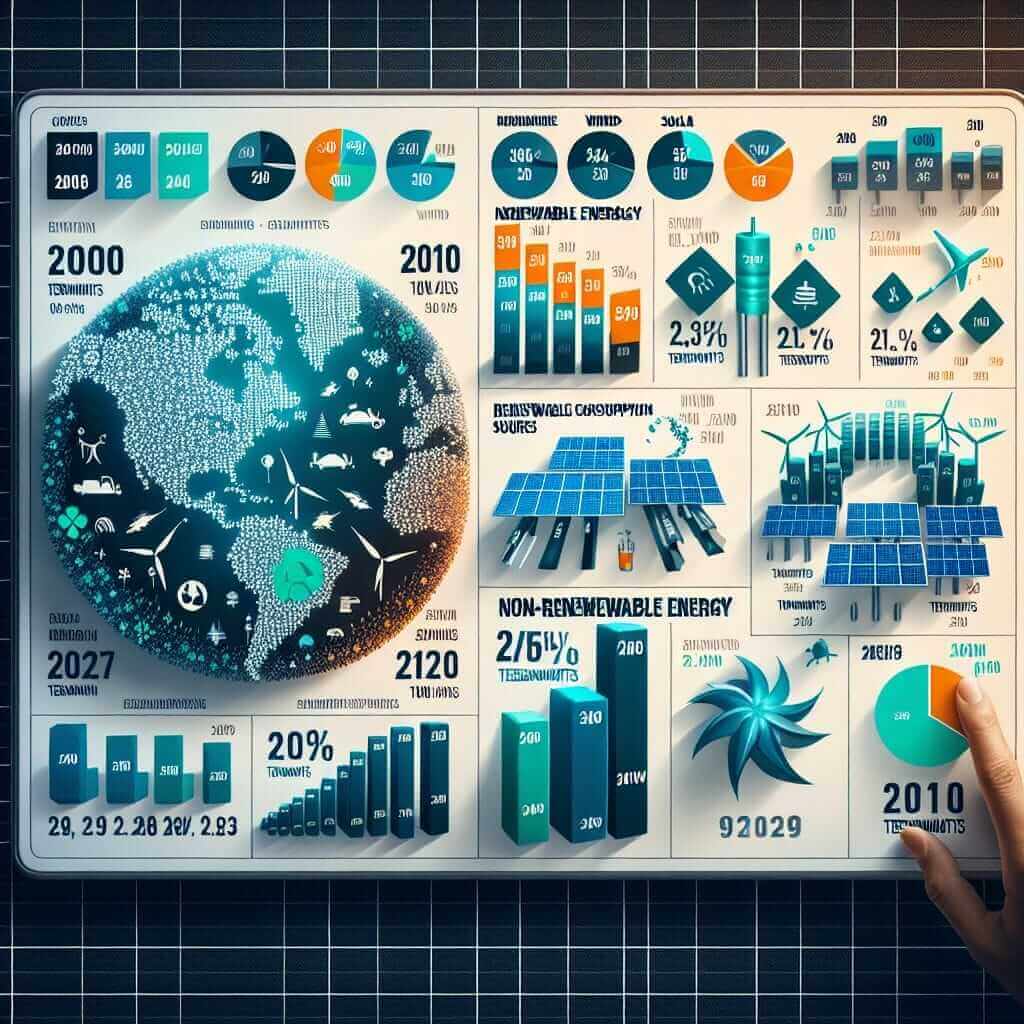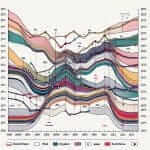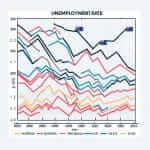The topic of energy production, particularly the comparison between renewable and non-renewable sources, frequently appears in the IELTS Writing Task 1. Understanding the nuances of this topic and mastering the relevant vocabulary can significantly enhance your ability to craft a high-scoring response.
This guide will provide you with:
- Sample IELTS Writing Task 1 questions on the topic.
- A breakdown of key vocabulary related to renewable and non-renewable energy production.
- A model answer to a sample question, complete with a data table.
- Essential tips for achieving a Band 7+ score in your IELTS Writing Task 1.
Sample IELTS Writing Task 1 Questions
Here are some potential questions you might encounter related to renewable vs. non-renewable energy production:
- The chart below shows the percentage of electricity generated from renewable and non-renewable sources in a European country between 2000 and 2020. Summarize the information by selecting and reporting the main features, and make comparisons where relevant.
- The table illustrates the global consumption of renewable and non-renewable energy (in terawatt-hours) over two decades, from 2000 to 2020. Write a report for a university lecturer describing the information shown.
- The graph compares the cost of producing one megawatt-hour of electricity using wind power and coal in a particular region from 2010 to 2023. Summarize the information by selecting and reporting the main features and make comparisons where relevant.
Choosing a Sample Question
For this guide, let’s focus on the following question:
The table illustrates the global consumption of renewable and non-renewable energy (in terawatt-hours) over two decades, from 2000 to 2020. Write a report for a university lecturer describing the information shown.
Data Table:
| Energy Source | 2000 (TWh) | 2010 (TWh) | 2020 (TWh) |
|---|---|---|---|
| Coal | 60,000 | 75,000 | 80,000 |
| Oil | 85,000 | 95,000 | 100,000 |
| Natural Gas | 50,000 | 65,000 | 80,000 |
| Hydropower | 10,000 | 12,000 | 15,000 |
| Wind Power | 500 | 2,500 | 10,000 |
| Solar Power | 100 | 1,000 | 8,000 |
 Global Energy Consumption
Global Energy Consumption
Analyzing the Task
- Task: You need to write a report summarizing the given data.
- Target audience: Your report is intended for a university lecturer, indicating a need for formal language and an objective tone.
- Data type: The data is presented in a table format, requiring you to compare and contrast figures across different categories (renewable vs. non-renewable) and time periods.
Model Answer:
The table provides a comprehensive overview of global energy consumption from both renewable and non-renewable sources over a twenty-year period, spanning from 2000 to 2020.
Overall, the consumption of all energy sources witnessed an increase during this period. However, the most striking trend is the significant rise in the use of renewable energy sources, particularly wind and solar power, although their overall contribution remained significantly lower than that of non-renewable sources.
In 2000, the global consumption of coal, oil, and natural gas – the leading non-renewable sources – stood at 60,000 TWh, 85,000 TWh, and 50,000 TWh, respectively. By 2020, these figures had risen to 80,000 TWh, 100,000 TWh, and 80,000 TWh, demonstrating a steady global reliance on these traditional energy sources.
On the other hand, the consumption of renewable energy sources showcased a much steeper increase. While hydropower, a well-established renewable source, experienced a gradual growth from 10,000 TWh to 15,000 TWh, the utilization of wind and solar power surged exponentially. Wind power consumption skyrocketed from a modest 500 TWh in 2000 to a substantial 10,000 TWh in 2020. Similarly, solar power usage witnessed an even more dramatic leap, rising from a mere 100 TWh to 8,000 TWh over the same period.
Despite the impressive growth of renewables, it is crucial to note that their combined consumption in 2020 remained considerably lower than that of any single major non-renewable source. This highlights the ongoing global dependence on fossil fuels for energy production.
(Word Count: 214 words)
Writing Tips for Band 7+:
- Paraphrase the question: Rephrase the question prompt in your introduction to demonstrate your understanding of the task.
- Overview: Provide a general overview summarizing the key trends before diving into specific details.
- Data Selection: Focus on the most significant data points. Avoid simply listing all figures; instead, highlight trends, comparisons, and contrasts.
- Vocabulary: Use a wide range of vocabulary related to trends (increase, decrease, fluctuate, surge, etc.) and comparisons (whereas, in contrast, similarly, etc.).
- Grammar: Pay close attention to grammar accuracy, especially subject-verb agreement, tense consistency, and the use of articles.
- Linking Words: Use cohesive devices (however, although, while, etc.) to connect ideas smoothly and logically.
- Formal Tone: Maintain a formal and objective tone throughout your writing. Avoid personal opinions or emotional language.
Essential Vocabulary:
- Renewable energy sources: Sources of energy that are naturally replenished, such as solar, wind, hydro, geothermal, and biomass energy.
- Non-renewable energy sources: Finite sources of energy that are depleted over time, primarily fossil fuels like coal, oil, and natural gas.
- Consumption: The amount of energy used.
- Generate/Generation: To produce energy.
- Terawatt-hour (TWh): A unit of energy equal to one trillion (10^12) watt-hours.
- Fossil fuels: Carbon-based fuels formed from the remains of ancient organisms, including coal, oil, and natural gas.
- Hydropower: Power generated from the energy of moving water.
- Wind power: Power generated from the kinetic energy of wind using wind turbines.
- Solar power: Power generated from the conversion of sunlight into electricity using solar panels.
Difficult Vocabulary:
- Exponentially (adverb) /ˌɛkspəˈnɛnʃəli/: At a very fast rate. (e.g., The use of solar power has increased exponentially in recent years.)
- Substantial (adjective) /səbˈstænʃəl/: Large in amount or importance. (e.g., Wind power now makes a substantial contribution to the country’s energy mix.)
- Modest (adjective) /ˈmɒdɪst/: Relatively small in amount or size. (e.g., The country had a modest wind power capacity in the early 2000s.)
- Dependence (noun) /dɪˈpɛndəns/: The state of relying on something. (e.g., There is a growing concern about the world’s dependence on fossil fuels.)
- Steep (adjective) /stiːp/: Rising or falling sharply. (e.g., The graph shows a steep increase in the use of renewable energy.)
By following these guidelines and familiarizing yourself with the key vocabulary, you can approach the IELTS Writing Task 1 questions on renewable vs. non-renewable energy production with confidence and enhance your chances of achieving a Band 7+ score. Remember, practice is crucial for mastering any skill, so continue to hone your writing abilities through consistent effort and targeted preparation.


